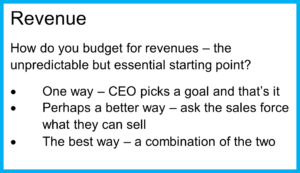 Earlier this month I wrote about the need to get on with planning your company’s financial goals for 2023, and I pointed readers to an online course to help those who either have never done this before or need a refresher on how to do it right. The image at left is one slide from that course. I’ve been asked to elaborate on it, since the visual materials did not go into much detail to reinforce the narrative around the creation of a viable revenue budget. So let’s cover that in a bit more depth this week.
Earlier this month I wrote about the need to get on with planning your company’s financial goals for 2023, and I pointed readers to an online course to help those who either have never done this before or need a refresher on how to do it right. The image at left is one slide from that course. I’ve been asked to elaborate on it, since the visual materials did not go into much detail to reinforce the narrative around the creation of a viable revenue budget. So let’s cover that in a bit more depth this week.
Randy McDonald, a long-time friend and partner in a startup venture decades ago made the point that “Nothing happens until you sell something,” and he was right, to a point. Technically of course there are steps every company must take leading up to making a sale, but the opportunity to actually make a profit requires that something gets sold for enough money to cover the cost of those early steps. So I might rephrase Randy’s rule to say “Nothing happens that will enable the company to succeed until it begins selling something.” Doesn’t quite roll off the tongue as well as the shorter version, but it is a good opening for my point today: How does the CEO develop a viable sales forecast that can be the basis for a budget?
So back to my slide above with the two options: (1) The CEO tells everyone the goal, or (2) the CEO learns from the sales force what they think they can sell. The first is likely to be overly optimistic and the second likely to be overly conservative. So how to get the best of both worlds? It truly must be a collaboration of the management team, including sales management, product sourcing, marketing, and finance.
One of our most management-conscious clients holds an annual strategic planning retreat that has a key goal: Negotiate and agree on the revenue plan for the coming year, that critical first step in creating a budget. In one management retreat the CEO gets to guide the team to reach for a higher goal but he also gets the sales team to point out obstacles. Ultimately everyone buys into the resulting plan, a huge step in getting an achievable forecast. Now it’s the job of the management team to remove the obstacles to reaching that goal. Some considerations:
At last! Now we’ve got a plan and we’re ready for the new year. Are you ready? Not sure? Not at all? Call us.
We are Your CFO for Rent.
© 2024 CFO For Rent - Western Management Associates. All rights reserved. Website by Avodah Web Solutions.